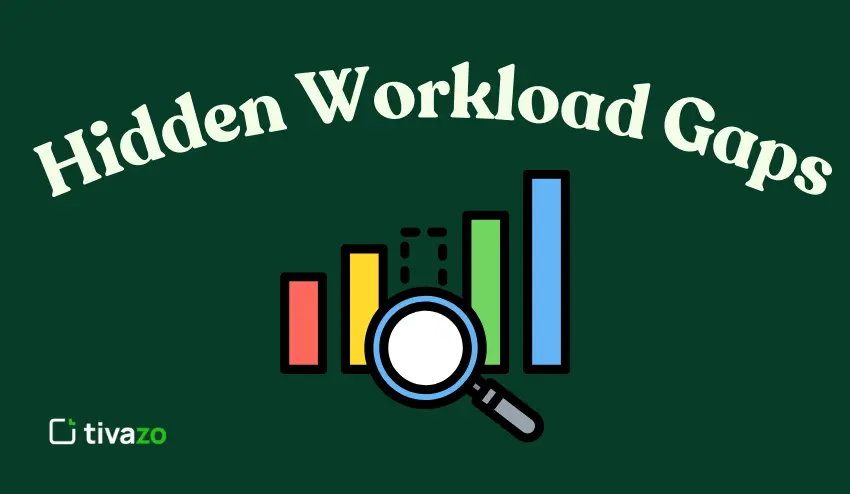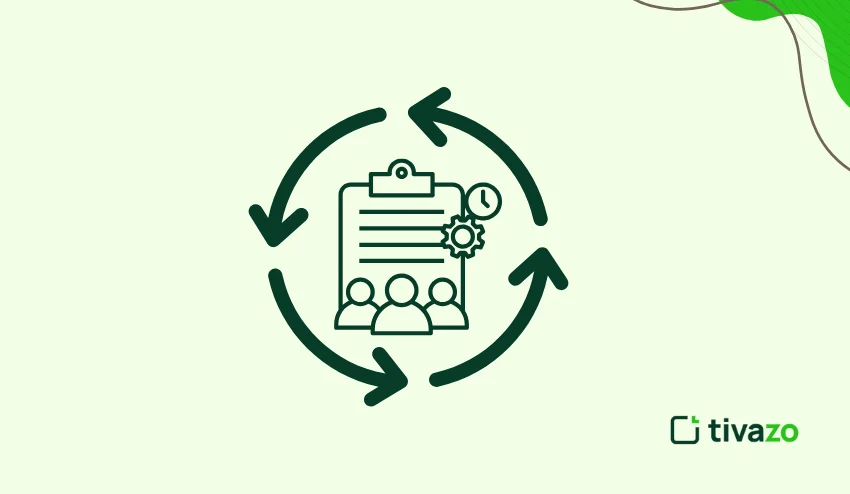Your team is being more productive than ever, but it seems like productivity is in quicksand. Sound familiar? You’re not alone. According to recent research in the workplace, large percentages of productivity-wasting activities are entirely unseen in the management and thus forming what researchers have termed as hidden workload gaps.
These loopholes are not externalities that are only slightly inefficient. They are mute productivity murderers that cost organizations at an average of 15-20 hours per employee per week. Your team might seem relentlessly working on the visible projects and meeting deadlines, but there is a whole layer of work coming in and out of the view to exhaust your team and take up many of their hours.
There are gaps in workloads that are at each and every tier of your organization, whether it be HR managers that are actually overwhelmed with administration work to the project managers who are always spending hours on how to work between the systems that are not interconnected. The result? Staff burnout soars, innovation halts and your top talent begins to seek other options. The good news is, however, that as soon as you learn how to identify these gaps, you are able to remove them and unleash the real potential of your team.
What Are Hidden Workload Gaps?
The Definition That Every Leader Needs to Know
The invisible tasks, coordination, and mental labor that employees do every day but which are not visible in job descriptions or productivity measures make up hidden workload gaps. These gaps are the gap that exists between what work looks on paper and what actually occurs in reality.
Consider your marketing manager who is spending two hours every Monday re-formatting reports of various departments. Or your operations department head who keeps on troubleshooting software integration problems that ought to be running smoothly. Such activities are productivity killers and are not visible at all on the leadership dashboards.
Why These Gaps Stay Hidden From Management View
The conventional productivity indicators are mostly on the outputs and the time limits, but not on the unseen efforts that are needed to accomplish them. There are still workload gaps as they are hidden in the form of remembering work and work coordination that does not have an actual output.
These gaps are concealed by three factors. To begin with, invisible tasks are sometimes perceived by the employees as part of the job and will not be reported when discussing workload. Second, a lot of gaps include emotional labor and relationship management which is too subjective to measure. Third, these coordination tasks are even less visible to managers in remote and hybrid work environments.
The outcome is the productivity paradox: teams may seem effective on the surface level, but be overworked and overloaded with cognitive tasks and fragmented tasks under the surface.
The True Cost of Hidden Workload Gaps
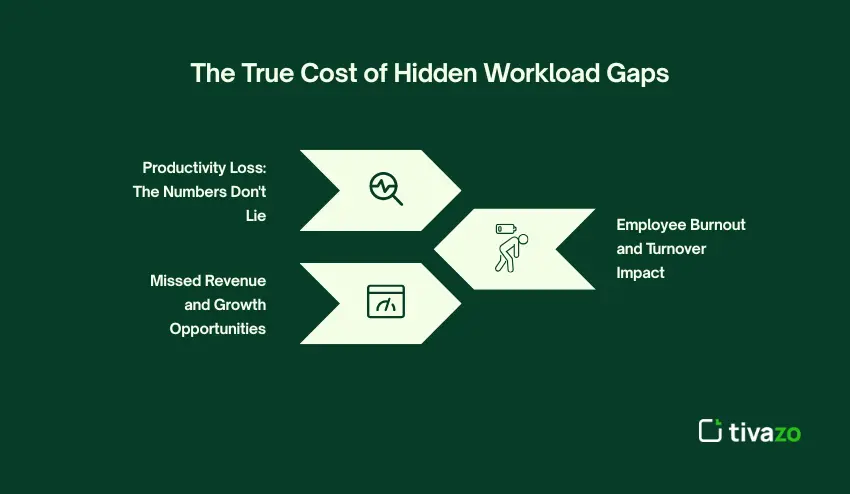
1. Productivity Loss: The Numbers Don’t Lie
Unseen workload leaks cause an appalling sink to organizational productivity that most leaders never expect. Studies indicate that employees dedicate 15-20 hours per week to invisible work-related activities which is almost half the time they work. It means that organizations with average salaries lose between $18,000 and 24,000 of their productivity per employee per year.
Take this example: your finance department is taking 3 hours per week to reconcile data between systems that are supposed to be automatically reconciled. Your HR department wastes 5 hours every week in employee record keeping in various platforms. In the meantime, the project managers spend 4 hours a week in meeting coordination and follow-ups that contribute no strategic value.
2. Employee Burnout and Turnover Impact
The burden of hidden gaps in workloads is more likely to lead to burnout than the visible work stress. Workers claim to be tired even though they do not do much of any significance, an immediate consequence of switching contexts all the time and mental overhead due to the invisible work.
Organizations that have not filled their hidden workload gaps record 40 percent more turnover rates among high performers. According to the Harvard Business Review, women employees are assigned 44 percent of non-promotable jobs, which leads to increased burnout and stagnation in their careers.
3. Missed Revenue and Growth Opportunities
Innovation is hit when your best talent is working half of their time on invisible work. Strategic initiatives, customer relationship building, and revenue-generating activities cannot be undertaken by teams in large quantities. A single software company found out that their product development team was wasting 25 hours a week on administrative overhead- that is, the strategic contribution of half a full-time developer gone forever.
7 Types of Hidden Workload Gaps
1. Administrative Task Accumulation
The most prevalent form of workload gaps is administrative burden. Such activities increase silently because workers become informal managers of their departments. Your marketing manager makes updates to three systems of vendor contacts. The hand-generated reports in your operations are supposed to be automated. Your HR department is using up hours weekly on employee data that is in various formats.
The administrative distance increases when the employees accept the tasks with the aim of completing them as opposed to handling systematic problems. A mid-sized company discovered that their departmental heads were spending 35 hours a week together on office work that could be automated or done away with.
2. Communication and Coordination Overhead
Contemporary workplaces generate massive communication burdens that are hardly reflected in productivity metrics. Your project managers also spend hours in a week scheduling meetings with various calendars. Through team leads, information is always communicated to different stakeholders through different channels. Remote employees spend a lot of time planning handoffs between the members of the team working at various time zones.
This hidden workload gaps is aggravated by the fact that teams adopt multiple communication platforms without defined protocols. The process of searching information in Slack, email, project management tools and shared drives, which amounts to an invisible work, consumes time and breaks attention, as well as decreases the capacity to work deeply.
3. Technology Maintenance and Troubleshooting
All technology solutions claim to be efficient but in many cases they introduce new types of invisible work. Your finance department is always troubleshooting accounting software and banking system integration problems. Due to the lack of compatibility between systems, marketing groups waste hours rewriting content on various platforms. IT departments deal with minor technical problems all the time which disrupt the working process of other employees.
These technology gaps get compounded with time as organizations continue to add new tools without getting rid of the old processes. The employees act as unofficial IT support to their respective departments and wastage of time in areas that are not related to their areas of expertise is experienced.
4. Non-Promotable Work Distribution
Tasks that cannot be promoted leave some of the most harmful hidden workload gaps since they eat time without giving an individual a chance to grow their career. These involve organizing office events, orienting new employees in informal processes, sustaining team culture programs, and organizing social events. Studies indicate that these activities are overburdened to women and minority workers.
They are often undertaken by your high-performers who are concerned about the success of the team but this invisible work does not allow them to concentrate on strategic contributions that can propel their own careers and provide quantifiable value to the business.
5. Context Switching and Task Fragmentation
The contemporary workplaces require employees to alternate between various kinds of work all the time, which poses a significant cognitive load. Throughout the day, your sales force switches between CRM updates, client calls, writing proposals and internal meetings. Every shift needs a psychological effort to concentrate and in most cases, it leads to partial attention to critical activities.
This fragmentation is a very pernicious type of hidden workload gaps since it diminishes quality output in all the activities. Employees are busy and stressed doing less meaningful work in comparison to the amount of time they are spending.
6. Remote Work Coordination Gaps
Remote and hybrid workplaces pose special hidden workload gaps, which are not present in traditional offices. Staffs waste more time in planning basic activities that were easy when all the staffs were operating in one place. The scheduling of meetings over time zones is complicated. The exchange of information involves additional measures to keep the members of the remote teams abreast of the information.
Workers who work remotely are prone to putting in invisible work to ensure that their relationship with the team members and their visibility to the management. This affective work involves additional check-ins, excessive communicating to show productivity, and extra work to engage in team culture remotely.
7. Knowledge Transfer and Documentation Burden
Organizations are dependent on informal knowledge transfer that develops huge work burdens in the invisible work. Your long time employees waste hours in explaining processes that have not been well documented. New employees need a lot of informal training outside the formal onboarding programs. Leaving employees consume a lot of time in passing institutional knowledge that is only in their experience.
This gap in knowledge increases when the organization fails to invest in the right documentation systems and the employees are left to answer the same questions repeatedly and explain the processes that are supposed to be captured and made available in a systematic manner.
The 5-Step Framework for Identifying Hidden Workload Gaps
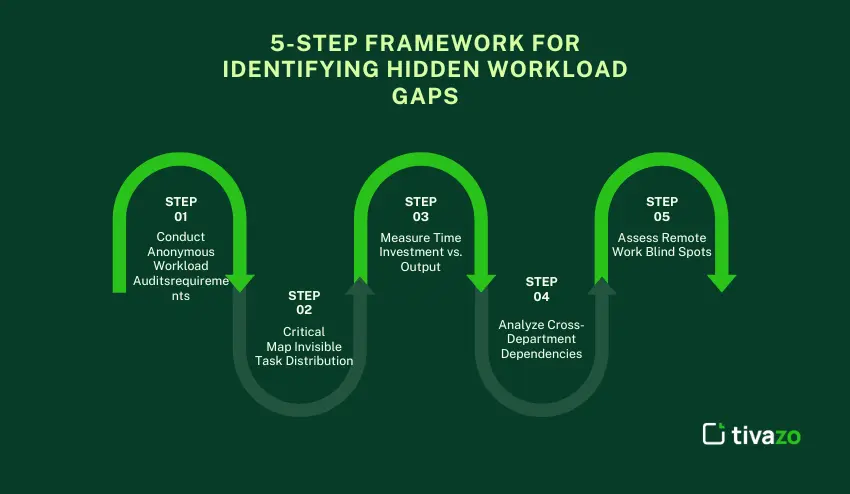
Step 1: Conduct Anonymous Workload Audits
Begin to detect hidden workload gaps by establishing secure areas where employees can report invisible workload. The anonymous surveys are effective since employees are usually reluctant to lament about work that they were doing silently. Your hidden workload gaps audit must pose certain questions regarding the time on coordination, administration, troubleshooting, and informal training.
Ask questions such as: What are some of the tasks that you do on a regular basis but are not in your job description? and “how much time do you spend each week on work not reflected in your productivity metrics? Give the groups of meeting coordination, system troubleshooting, informal mentoring, and cross-department communication to make employees be aware of these patterns of hidden workload.
Step 2: Map Invisible Task Distribution
Develop a map of the distribution of hidden workload gaps in your organization. Follow up on meeting coordination, system maintenance, informal training and administrative overflow. Identify trends where some employees always volunteer to coordinate or do technical troubleshooting duties other than their job descriptions.
Record task allocation in departments using basic spreadsheets. Find employees who do routine jobs such as formatting team reports, scheduling cross-department meetings or training new employees on unofficial processes. This mapping shows that workload imbalances, which are hidden, cause productivity drain.
Step 3: Measure Time Investment vs. Output
Measure the real time that your team spends on the hidden workload gaps versus their strategic contributions. Ask employees to trace invisible work in two weeks, coordination work, administrative overhead, switching context, and troubleshooting work. Compare this data of hidden workload gaps with their quantifiable outputs and deliverables.
This index tends to show appalling imbalances. Employees who perform well can also be expected to spend 40 percent of their time on non visible tasks and get recognized on visible deliverables only. Track the time-based data on the patterns of hidden workload gaps in your organization using time tracking tools or basic logging sheets.
Step 4: Analyze Cross-Department Dependencies
Trace the dependency between the departments that slows overall productivity caused by the gaps in hidden workloads. Chains of document communication needed in simple decisions. Monitor the flow of information between teams and see where there are bottlenecks where employees waste too much time in cross-departmental coordination.
Identify instances where an individual acts as the liaison between departments unofficially and does the overhead communication that is to be formalized. These dependency patterns tend to expose organizational structure concerns that provide unnecessary hidden workload gaps to individual employees.
Step 5: Assess Remote Work Blind Spots
Remote and hybrid environments generate other latent gaps of workload that need special consideration. Question remote workers regarding additional hours that are spent on keeping in touch, talking with on-site workers, and dealing with technology issues. Record extra meeting hours needed to work remotely as opposed to working in person.
Determine the presence of invisible work by remote workers in trying to maintain relationships, over-communicating to show that they are productive, or making an additional effort to engage in team culture. These are remote specific hidden workload gaps that a manager is not aware of because he or she is more concerned with the completion of deliverables and not the coordination effort.
Essential Tools for Managing Hidden Workload Gaps
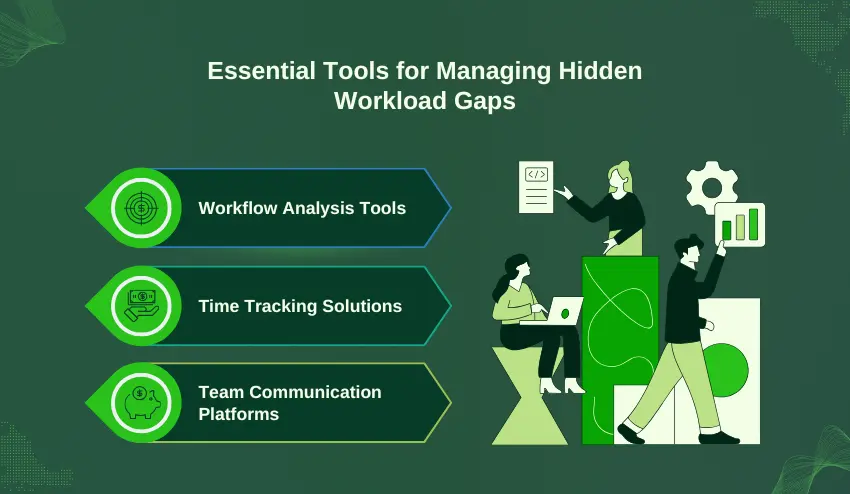
1. Workflow Analysis Tools
To determine the existence of hidden workload gaps, you must be able to see the flow of work in your organization. Process mining software such as Celonis and Microsoft Process Advisor are automated solutions to follow task sequences and define bottlenecks in which latent workload gaps are concentrated. These platforms expose coordination overheads that conventional productivity measures lack.
In the case of smaller organizations, workflow visualization tools such as Monday.com and Asana can be used to map workload gaps that exist in the background between departments. Their automation capabilities eradicate repetitive coordination workloads that form the invisible work loads behind these hidden workload gaps.
2. Time Tracking Solutions
Proper quantification of the hidden workload gaps requires precise time recording that involves the invisibility of work activities. RescueTime also automatically classifies computer usage to show you how much time you are spending on administration and how much time you are spending on productive work to quantify your organizations workload gaps. Toggl Track enables employees to record coordination time, meeting preparation, and other types of invisible work that are not recognized by other productivity tools.
Tivazo has team-wide time tracking and custom categories created specially to record unidentified gaps in workload such as system troubleshooting, informal training, and cross-department coordination. This information forms the basis of eradicating these hidden workload gaps in a systematic way.
3. Team Communication Platforms
Centralized communication eliminates hidden workload holes that are caused by the fragmentation of information in various channels. Slack when channels are organized correctly does away with the invisible workforce of monitoring conversations in email, messaging, and project tools- a significant source of unseen workload gaps. Microsoft Teams is a combination of communication, file sharing, and project management to minimize overheads of context switching.
Notion is a single platform that brings together documentation, project management and communication, eliminating hidden workload gaps that arise when employees seek information in separate systems. This consolidation eradicates hours of unseen work of coordination each week and ensures that new gaps of workload which are invisible do not arise.
Conclusion
Hidden Workload Gaps are costing your organization 24,000 per employee a year and incinerating your finest talent. The unseen work that takes 15-20 hours a week is not merely inefficiency, but a competitive disadvantage.
Companies that eradicate the gaps in hidden workloads are better innovators and retainers than their competitors. These best practices enabled TechCorp to regain 127 productive hours per week.
Begin with the 10-point checklist today. Start with a workload survey anonymity to identify where the workload loopholes are in your organization. These productivity drains must now be turned into competitive advantages.
